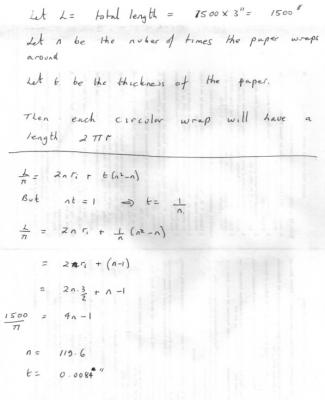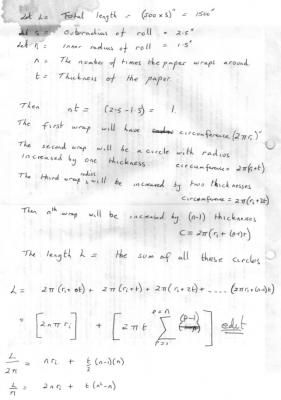-
Posts
18270 -
Joined
-
Last visited
-
Days Won
104
Content Type
Profiles
Forums
Events
Everything posted by studiot
-
To do what you ask you need to go back in the analysis to the opoint where the equations of motion are mgcos(&) - T = -ml(d&/dt)2 -mgsin(&) = ml(d2&/dt2) Your equation is the second one. Multiply this by (d&/dt) and integrate 0.5ml(d&/dt)2 = mgcos(&) + Constant Apply boundary condition for when & = 0 and solve. Edit sorry for using & instead of theta but I don't have my usual stuff available.
-
My first question would be are you going to create the cyclic ketone before or after the nitrogen bridge?
-

Make KNO3 from salt mix of 70% KCl & 30% NaCl
studiot replied to navyou14's topic in Inorganic Chemistry
What did you want potassium nitrate for and how much did you intend to make, may I ask? -
Exactly.
-
Can't wait to find out, so do tell when you know. PS I can recommend a good shelter for the homeless if she throws you out.
-
I think you misunderstand what I mean. In tech drawing and differential geometry we can open out the surface of a cylinder (map it) to a plane because it has zero thickness. As soon as we have a rectangular parallelepiped of substance the thickness becomes important when we bend it in any way. I could add a 'transition curve' to the junction of each wrap in my series solution and also calculate for the centreline or mean radius but that would add complications of higher order, small in overall effect but large in difficulty.
-
The volume of the stack will not match the volume between the two cylinders exactly.
-
Because if part of it is stretched, or more difficult- compressed, then its volume and surface area changes.
-
Unfortunately you cannot roll the paper round a cylinder without distortion if it has any thickness whatsoever. In order to force it to lie 'flat' (contiguous) one side must be longer than the other.
-
Furthermore , R, Cv and the quantity of gas are all given in engineer's units (kg- somethings) so n is not needed.
-
The point is that if the internal energy depends only upon temperature and temperature does not change then the internal energy does not change. That is dU = 0. That is q = -w = RT ln(V2/V1) = RT ln(P1/P2) Which is an expanded version of the formula scott's tutor provided.
-
We are assuming an ideal gas. Which brings us to the dreaded first law and internal energy. The internal energy of an ideal gas depends only upon the temperature. At the very beginning, swansont asked you what isothermal means. So what are the implications of this being an isothermal process?
-
+1 And whatsmore he was doing the usual misdirection ie he was looking at the wrong variables at the wrong point.
-
I noted that the actual curve is not a true spiral or any regular curve.
-
OK I now have 8thou after arithmetic correction by my series method, which is really also quite simple. Since imatfaal has posted a valid method (I like it +1) here is mine.
-
I said others were interested. It is a good problem, admitting of many methods of attack. How did your numbers work out imatfaal?
-
This question has interested others, but I can't post a full solution until after your deadline. I made the thickness 0.00627 inches and the number of wraps 159.48, but of course my arithmetic is notedly fickle. I can however help you further to develop a solution, though I can see you are a thinking sort of student who like to do for himself where possible. So ask as many question as you like. How are you getting on putting my post#4 formulae into an equation? You will need to know what the sum to n terms for the natural or counting numbers is 1 + 2 + 3 + 4 +...............n = 1/2n(n+1) So the sum of the first six terms is 1+2+3+4+5+6 = 0.5(6)(7) = 21 Do you understand summing series? You will need to make a slight adjustment to the above to allow for the fact that we are starting at zero not 1 Can you do this? Ask if you need help here.
-
I should perhaps note that the shape is not a true spiral. The first time the paper is wrapped round it is wrapped round a perfect circle since it touches the circular inner tube all the way round. Where is come back to its start point the paper suddenly increases its radius by exactly one thickness of paper and again transits round in a perfect circle. and so on. We can, of course, form a second equation connecting the number of wraps or circles (n) and the paper thickness (t) since each thickness is stacked side by side between the inner and outer radii of the paper. We thus have two equations connecting n and t and can therefore solve them. Please note the area of the paper is not relevent to this exercise. It is the lenght that matters. Of course the number of sheets times the sheet length still equals the total length.
-

Quick help with MOSFETS, where do the electrons come from?
studiot replied to CasualKilla's topic in Engineering
Strong opinions. I think I'll just rest on my Zimmer Frame for now. You were obviously too tired to bother to look it up whilst you were resting on yours. For the benefit of those, less rude, who might also like to know. Charge carriers respond differently to force fields when in solids than they do when in a vacuum. The constant of proportionality between force and apparent aceleration is called effective mass. For electrons this is still usually positive. But for holes it can be positive or negative. (and yes holes act as if they were massive objects) -
If r is the radius of the inner tube then its circumference is [math]2\pi \left( r \right)[/math] After the first time we have wrapped the paper, of thickness t, once round it completely the new circumference is [math]2\pi \left( {r + t} \right)[/math] So the second time we wrap the paper completely round its length is [math]2\pi \left( r \right) + 2\pi \left( {r + t} \right)[/math] The third time we wrap around the circumference has grown again to [math]2\pi \left( {r + 2t} \right)[/math] So the length of paper is [math]2\pi \left( r \right) + 2\pi \left( {r + t} \right) + 2\pi \left( {r + 2t} \right)[/math] So if we wrap around n times the circumference is edit [math]2\pi \left( {r + \left( {n - 1} \right)t} \right)[/math] If you develop this it will give you a formula for the length of the paper in terms of the thickness and the number of whole wraps around. Sorry had to edit the LaTex This may be an 11th grade sum, I don't know your system.
-
Hello and welcome, handsonic. No it is fine to post here any sort of technical question. But surely this is beyond 11th grade? What you are asking is the length of part of a spiral. Can you see that the paper forms a spiral round the inner tube with total length equal to the number of sheets times the length of a sheet? Can you tell us what sort of approximate methods you can use to find and answer? PS Is this really 11th grade homework or a challenge of some sort?
-
Both right. Just to add the system is closed because no matter (mass ) leaves or enters. So work and/or heat are exchanged with the surroundings and our goal is to evaluate each, bearing in mind that these exchanges take place at constant temperature. We are told that the gas expands So what changes and which way is any work 'exchanged' ie what does work on what? Once that is decided we can find a formula to calculate the value of that work, if any. If we expanded a gas what would normally happen to the temperature of that gas?
-
REad through your equation and ask yourself What does it say in words? Never mind the numbers (stochiometry) for the moment. Just what is happening. Something along the lines of ___?___combines with _____?____ in the presence of _____?_____ And I hope we are now agreed that combines with oxygen = burns.
-
Down the pub? Did you look at my link first?
-
Was it so long ago? I asked you what an open system was. Swansont asked you what isothermal meant. Both are mentioned in your set question.



